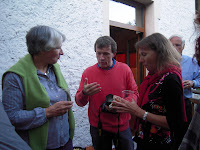




Bonjour mes amis! The Dordogne River Valley is a "melange" of natural and man-made beauty. This southwestern area of France includes walnut orchards, cornfields which are growing food for ducks and geese, and limestone cliffs supporting stone fortresses. During the Hundred Years' War, the Dordogne River separated battling England and France. Lee and I arrived in Sarlat, which is a charming town, in the heart of the Dordogne Valley. After dinner, June 1, we decided to explore Sarlat on our own. Due to limestone used for construction of its buildings, the town has golden tones. We began with a visit to the Cathedral of St. Sacerdos, which has a facade with 12th century carvings. The religious believed that Mary rescued them from the great plague of 1348 so there are many Virgin Marys in the interior of this church. Continuing on our walk, we discovered the Lantern of the Dead (Lanterne des Morts). Dating from 1147, this is the oldest monument in town. Within four days, 1/4 of Sarlat's population died of the plague (1,000 out of 4,000). People prayed to St. Bernard of Clairvaux for help. He blessed their bread and, at the same time, instituted health standards which stopped the disease. This lantern, or cone shaped tower, was built to show their gratitude. From here, we walked to Rue de la Salamandre. The salamander, which is not affected by water and fire, is Sarlat's symbol. Sarlat, as well, was not adversely affected by wars or floods. Down this street is a Gothic-framed doorway which has a tower which houses a staircase. Staircase towers similar to this date from the 1600s, after the religious wars between the Catholics and Protestants. Finally, we arrived at Place de la Liberté. This has been Sarlat's main market square since the Middle Ages. Across the square, dark stone roofs topped the buildings which are typical of this region, called lauzes. The flat limestone rocks were gathered by farmers clearing their fields, then made into roofing materials. These roofs have an unusually steep pitch and last up to 300 years. We continued on to Place des Oies, which is the "Square of Geese". Ducks and geese are important business in Sarlat since the Middle Ages. We found goose and duck liver pâté as a staple on restaurant menus and throughout marchés in the Dordogne River Valley. This spread is made from geese and ducks, or from a combination of the two. There are two basic forms: entier and bloc. Both are 100% foie gras; entier is a piece cut directly from the product, while bloc has been whipped for easier spreading. Foie gras is usually served with a sweet white wine. Foie gras, anyone?
Mme. Wallace



















































